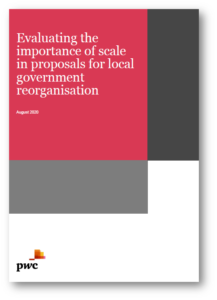New analysis reveals that single unitary councils could deliver £3bn saving over five years and ‘maximise’ the benefits of economic growth and housing policy
CCN Latest News, CCN News 2020 | 28 August 2020
Today the County Councils Network (CCN) publishes new independent evidence on the implications of local government reorganisation in two-tier shire counties ahead of the publication of the government’s ‘devolution and local recovery’ white paper.
With councils in shire counties facing billions in rising costs for care services, alongside financial deficits caused by the Coronavirus pandemic, the study from PricewaterhouseCoopers (PwC) shows merging district and county councils in each area into a single unitary council could save £2.94bn over five years nationally.
 Download the report here.
Download the report here.
The report concludes a single unitary in each area would reduce complexity and give communities a single unified voice to government. It would provide a clear point of contact for residents, businesses and a platform to ‘maximise’ the benefits of strategic economic growth and housing policy; integral to the ‘levelling-up’ agenda and securing devolution.
However, the report shows replacing county and districts with two unitary authorities in each area would reduce the financial benefit by two-thirds to £1bn over five years, with three unitary authorities delivering a net loss of £340m over the same period. A fourth scenario of a two-unitary and children’s trust model in each county would deliver a net five year saving of £269m.
Alongside a minimum £1.9bn in additional costs from splitting county council services, the report outlines the establishment of multiple unitary authorities in each area creates the risk of disruption to the safeguarding of vulnerable children, while ‘instability’ in care markets could impact on the quality and availability of support packages and care home placements.
The report has been covered across BBC News today. Read an online write-up here.
On the implications of a two-unitary and trust model, PwC conclude this would lead to additional cost, complexity and potential instability in how commissioning arrangements were managed. It also suggests there is limited evidence the implementation of these types of models can lead to immediate improvements.
CCN says that the report outlines a ‘compelling’ financial case for the creation of more single county unitaries in areas where councils seek reorganisation. This will help ‘safeguard’ council services in the wake of the pandemic, while ensuring councils are of the necessary size to drive forward the economic recovery and devolution agendas.
But the network warned that an arbitrary population limit in the White Paper would lead to a ‘missed opportunity’ and ‘worse deal for local taxpayers’, creating ‘significant risks’ and instability in vital care services, and holding back the levelling up agenda.
The report, ‘Evaluating the importance of scale in proposals for local government reorganisation’, reveals:
- A single county unitary in each of the 25 remaining two-tier areas could generate savings of £2.94bn over the next five years, a saving of £126m for a mid-sized county area. Creating two unitary authorities in each shire county would reduce the potential savings by two-thirds to £1bn over five years; £51m for a mid-sized county area. Three unitary councils for each area would cost £340m across all 25 areas over five years, a cost of £1.6m for the mid-sized county area.
- Creating multiple unitaries for each area would mean splitting up children’s social services and adult social care departments which are currently overseen by county councils. PwC concludes this creates risks at a time when demand for both types of care will rise post-Coronavirus, and that ‘the likelihood of performance dropping is high.’
- The report finds that disaggregating care services could result in different councils competing over scarce care providers, potentially destabilising local adult social care markets already under additional strain due to Covid-19. It would also make children’s social services costlier and undermine efforts to attract and retain high calibre directors with sufficient experience.
- PwC suggests that, for the scenarios explored in the report, creating two or more unitaries in each county could potentially create and concentrate economic disparities, with one council benefiting from higher economic activity and local tax income. PwC argues that the creation of a combined authority alongside multiple unitaries to oversee growth and transport functions would be unprecedented and has no guarantee they will perform better in this new arrangement, nor that economic growth for the county is maximised.
- In conclusion, PwC summarise that the “implementation of single unitaries in each of England’s two-tier areas would deliver significantly greater benefit” and if “an alternative approach be pursued the process of disaggregating current county services does present a number of material costs, but also non-financial risks and complexities”.
 Cllr David Williams, chairman of the County Councils Network, said:
Cllr David Williams, chairman of the County Councils Network, said:
“The consequences of Coronavirus for local government finances, and the need to work quickly to support the economic recovery, means more councils want to look again at how local government is structured in their area.
“This government has already signalled that it wants to see many more unitary councils created and it is important we get it right for our residents – we do not want to look back on this period as a missed opportunity.
“The findings from PwC show there is a compelling financial case for the creation of more unitary counties where councils seek reorganisation. They will provide significant savings to support frontline services and the stability needed to safeguard care services as we continue to mitigate the impact of Coronavirus. Crucially, it will create councils of the necessary size to support local economies to recover from the pandemic and drive forward the devolution and levelling up agendas.
“In contrast, an arbitrary population threshold that limits the size of any new council will cap our areas’ ambitions and create significant risks in delivering care services. This evidence shows it would mean a worse deal for local taxpayers, create confusion, costs, and complexity, and potentially deliver a postcode lottery for local services and the economic recovery.
“Unitary counties won’t lead to a democratic deficit. Rather, as evidenced by authorities that have already made this journey, they have the potential to bring services closer to residents, developing new ways for residents to engage and shape service provision more effectively and enhance local democratic participation with empowered town and parish councils”.
Notes to editor
- An executive summary of the report can be downloaded here.
- 25 county councils in England are responsible for between 80-90% of local expenditure on services, including social care, highways, transport and public health. 188 District councils across these areas provide services such as planning, waste and street cleaning. The report by PwC modelled the financial implications of merging county and districts across four unitary scenarios and explored in detail the policy implications of reform across 20 lines of enquiry.
- PwC’s analysis models four different scenarios for reform in two-tier council areas. All of these options include the abolition of all district councils and the county council in each of the 25 remaining areas. The four scenarios are: one unitary per county; 2 unitary councils per county; three unitary councils per county; two unitary councils plus outsourcing children’s services to be run by a children’s trust. For a detailed financial analysis of each scenario, see page 24 of the report.
- The figures cited in this report draw on input data from all 25 two-tier county areas. Each area has been modelled, differentiating this analysis from previous studies where averages have been used. In addition, calculations have been made for an example mid-sized authority. These calculations should not be misinterpreted as being based on the average. The mid-sized authority calculations take current variations in scale across all 25 two-tier areas in England into account (there are a large number of two-tier areas which serve relatively small populations).
- The financial assumptions used to calculate benefits and costs are based on data from a representative sample of county councils, supplemented by other sources of publicly available information, alongside PwC’s own work with individual councils on reorganisation projects.
- The payback period referenced in the report is the period whereby there is a net financial saving resulting from the reorganisation. For scenario one, it is less than a year for both the total figure and for a mid-sized county; for scenario two it will be two years for the total figure and 1.8 years for a mid-sized county; for scenario three it could be eight years for the total figure and 5 years for a mid-sized county; for scenario four it would be 3.7 years for the total figure and 3 years for a mid-sized county.


 Download the report here.
Download the report here.  Cllr David Williams, chairman of the County Councils Network, said:
Cllr David Williams, chairman of the County Councils Network, said: